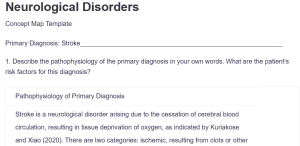Neurological Disorders
Concept Map Template
Primary Diagnosis: Stroke________________________________________________________
- Describe the pathophysiology of the primary diagnosis in your own words. What are the patient’s risk factors for this diagnosis?
| Pathophysiology of Primary Diagnosis | |
| Stroke is a neurological disorder arising due to the cessation of cerebral blood circulation, resulting in tissue deprivation of oxygen, as indicated by Kuriakose and Xiao (2020). There are two categories: ischemic, resulting from clots or other obstructions in blood vessels, and hemorrhagic, caused by leakage of blood into the brain. This deprivation causes the death of neurons and results in a variety of neurological deficits depending on the location of the stroke within the brain. | |
| Causes | Risk Factors (genetic/ethnic/physical) |
| Ø Thrombosis or embolism in an ischemic stroke.
Ø The cerebral blood vessels burst in a hemorrhagic stroke. |
Ø Risk factors include hypertension, hyperlipidemia, smoking, diabetes, and atherosclerosis. Genetic predispositions and ethnic backgrounds, such as African American and Hispanic populations, are also associated with increased stroke risk. Additionally, age and male gender can elevate susceptibility, as indicated by Moosa et al. (2023). |
- What are the patient’s signs and symptoms for this diagnosis? How does the diagnosis impact other body systems and what are the possible complications?
| Signs and Symptoms – Common presentation | How does the diagnosis impact each body system? Complications? |
| Ø Face, arm, or leg (particularly on one side of the body) suddenly becomes numb or weak.
Ø Having trouble comprehending, speaking, or being confused when being spoken to Ø Having vision problems in one or both eyes Ø Dizziness, imbalance, or loss of coordination |
Ø Nervous System: Paralysis, cognitive deficits, speech impairment
Ø Cardiovascular System: Potential for recurrence of strokes or myocardial infarction. Ø Musculoskeletal System: Weakness or complete loss of motor function. Ø Complications: Permanent disability, elevated risk of depression, pressure ulcers brought on by immobility, deep vein thrombosis, and infections (pneumonia) (Chohan et al., 2019) |
- What are other potential diagnosis that present in a similar way to this diagnosis (differentials)?
| Transient ischemic episodes, aura-accompanied headaches, hypoglycemia, seizures, and tumors are among the symptoms that mimic a stroke. |
- What diagnostic tests or labs would you order to rule out the differentials for this patient or confirm the primary diagnosis?
| Diagnostic tests, such as computed tomography scans or magnetic resonance imaging to identify the kind of stroke, are necessary for an accurate diagnosis. According to Choi et al. (2022), blood tests and echocardiograms may also be used to identify underlying diseases such as blood coagulation disorders or atrial fibrillation. |
- What treatment options would you consider? Include possible referrals and medications.
| · Ischemic stroke: Anticoagulants, antiplatelet medicines (aspirin), and thrombolytic treatment (tPA) administered 3-4.5 hours after the stroke commences (Campbell et al., 2019).
· Hemorrhagic stroke: Surgical interventions to stop bleeding and control intracranial pressure. · Long-term care: Referral to physical therapy, occupational therapy, and speech therapy for rehabilitation. · Medications: Antihypertensives, statins, and lifestyle changes to prevent recurrence |
References
Campbell, B. C. V., De Silva, D. A., Macleod, M. R., Coutts, S. B., Schwamm, L. H., Davis, S. M., & Donnan, G. A. (2019). Ischaemic stroke. Nature Reviews Disease Primers, 5(1). https://doi.org/10.1038/s41572-019-0118-8
Chohan, S., Venkatesh, P., & How, C. (2019). Long-term complications of stroke and secondary prevention: An overview for primary care physicians. Singapore Medical Journal, 60(12), 616–620. https://www.ncbi.nlm.nih.gov/pmc/articles/PMC7911065/
Choi, E. Y., Nieves, G. A., & Jones, D. E. (2022). Acute stroke diagnosis. American Family Physician, 105(6), 616–624. https://pubmed.ncbi.nlm.nih.gov/35704804/
Kuriakose, D., & Xiao, Z. (2020). Pathophysiology and treatment of stroke: Present status and future perspectives. International Journal of Molecular Sciences, 21(20), 7609. https://doi.org/10.3390/ijms21207609
Moosa, A., Osama, D., Alnidawi, F., Algillidary, S., Hussein, A., & Das, P. (2023). Risk factors, incidence, and outcome of stroke: A retrospective cross-sectional hospital-based study comparing young adults and elderly. Cureus. https://doi.org/10.7759/cureus.40614
ORDER A PLAGIARISM-FREE PAPER HERE
We’ll write everything from scratch
Question 
Concept Map Template
Primary Diagnosis: ___________________________________________________________
- Describe the pathophysiology of the primary diagnosis in your own words. What are the patient’s risk factors for this diagnosis?
| Pathophysiology of Primary Diagnosis | |
| Causes | Risk Factors (genetic/ethnic/physical) |
- What are the patient’s signs and symptoms for this diagnosis? How does the diagnosis impact other body systems and what are the possible complications?

Neurological Disorders
| Signs and Symptoms – Common presentation | How does the diagnosis impact each body system? Complications? |
- What are other potential diagnosis that present in a similar way to this diagnosis (differentials)?
- What diagnostic tests or labs would you order to rule out the differentials for this patient or confirm the primary diagnosis?
- What treatment options would you consider? Include possible referrals and medications.